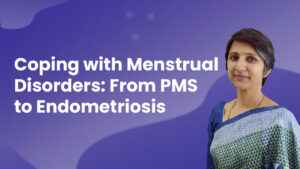Prior to knowing more about post menopausal bleeding, read about menopause here.
Post menopausal bleeding: Once a woman reaches menopause, she doesn’t have any bleeding or periods at all. Then the biggest question here is why a woman has any bleeding when she has already undergone menopause. Let us try to understand why it happens and why a woman should take it seriously and consult a gynaecologist even if she notices only spotting, but not bleeding as such. The reason is post-menopausal bleeding could be due to several causes including some very serious and life-threatening ones. Therefore, to rule out any serious medical conditions, women must see their gynaecologists even if they just notice spotting.
What causes postmenopausal bleeding?
Postmenopausal bleeding causes: There are many causes of this type of bleeding in women. In some cases, some women think that they have possibly reached menopause, but may begin to ovulate. Once this happens, bleeding begins. This is one instance of bleeding. Apart from this case, there are several other conditions that can lead to postmenopausal bleeding including endometrial atrophy, endometrial hyperplasia, polyps, cysts, and more serious endometrial and cervical cancers.
Endometrial atrophy
In post menopausal women, this condition affects the lining of the uterus. In endometrial atrophy, thin endometrial lining results in bleeding. This usually happens after menopause as low levels of Estrogen and progesterone cause the endometrium tissue that lines the uterus to get too thin further. This may result in bleeding.
Endometrial hyperplasia
Endometrial hyperplasia affects the endometrial lining of the uterus. This means the endometrial lining becomes thick in this condition. This is one of the prominent causes of postmenopausal bleeding in women. It happens when there is excess Estrogen, but less progesterone. In post-menopausal women, this is a common finding. If it is not addressed in time, it may lead to endometrial cancer a type of uterine cancer. Hormonal therapy or excess long-term Estrogen use may lead to endometrial hyperplasia.
Uterine polyps
Uterine polyps are abnormal, non-cancerous or benign growths, but can sometimes become cancerous. Irregular bleeding is a prominent symptom associated with this condition. This is a common problem in women who have gone through menopause. Uterine polyps can also cause problems in younger women.
Endometrial cancer
Another condition that may be associated with post-menopausal bleeding is endometrial cancer. It develops in the endometrium – a layer of the uterus. This has been seen in nearly about 10% of women who experience postmenopausal bleeding. The major symptom of endometrial cancer is abnormal bleeding and pelvic pain – owing to which many women approach gynaecologist – and therefore – the problem comes to the notice of doctors. When it is detected early, doctors remove the uterus to treat cancer.
Cervical cancer
Post menopausal bleeding can be due to several reasons and one such is cervical cancer. Slowly progressing cervical cancer causes post menopausal bleeding – which is a sign of cervical cancer. Regular physical examination and pap smear during a gynaecological check-up help in the identification of abnormal cells.
The symptoms associated with cervical cancer include abnormal bleeding, pelvic pain, abdominal discomfort and pain during sex.
What could be the other causes of post-menopausal bleeding?
The other less likely cause of postmenopausal bleeding includes trauma to the pelvis, endometritis (infection of the uterine lining), clotting problems, severe urinary tract infections, bleeding from the urinary tract due to other cause, and thyroid disorders. Postmenopausal bleeding could also be due to the side effects of certain hormonal medications.
Diagnosing the cause is Important
Even though there are several causes for post-menopausal bleeding, your gynaecologist’s main objective is to rule out potential life-threatening causes. Gynaecologists do physical examination suggests a few blood tests, abdominal ultrasound – and imaging tests such as CT scans. If they suspect any abnormality,
then to confirm the diagnosis of cancer, they order a biopsy of the excised cells and tissues. Endometrial biopsy [a small piece of tissue from the lining of the uterus (the endometrium) is removed] is mandatory for any postmenopausal bleeding. It can be an office biopsy or a hysteroscopic guided biopsy. Office biopsy is performed without anaesthesia in the doctor’s office. It hardly takes 10 to 15 minutes to complete. Your gynaecologist uses a flexible & thin tube with light and camera and inserts it through the vagina to examine the inside of the cervix and uterus. She takes a tissue sample. This procedure is known as a hysteroscopic biopsy. Based on the symptoms, physical examination, diagnostic tests and biopsy results the underlying cause is determined and the treatment is initiated accordingly.
How is post menopausal bleeding treated?
Post menopausal bleeding treatment: It depends on the cause of the bleeding. If the bleeding is due to endometrial atrophy or endometrial hyperplasia then your gynaecologist may prescribe hormone therapy. If polyps are the cause, then they are removed by hysteroscopy. For the treatment of endometrial or cervical cancer, a hysterectomy is done. Which is followed by radiation therapy, chemotherapy and hormone therapy.
Bottom line
Post menopausal bleeding is not normal even if it is merely spotting or mild or heavier flow. It should be brought to the notice of your gynaecologist. You do it the sooner the better. Whatever may be the cause of postmenopausal bleeding, your prompt action and approach to a gynaecologist help in early detection and even prevention of some serious health problems.




